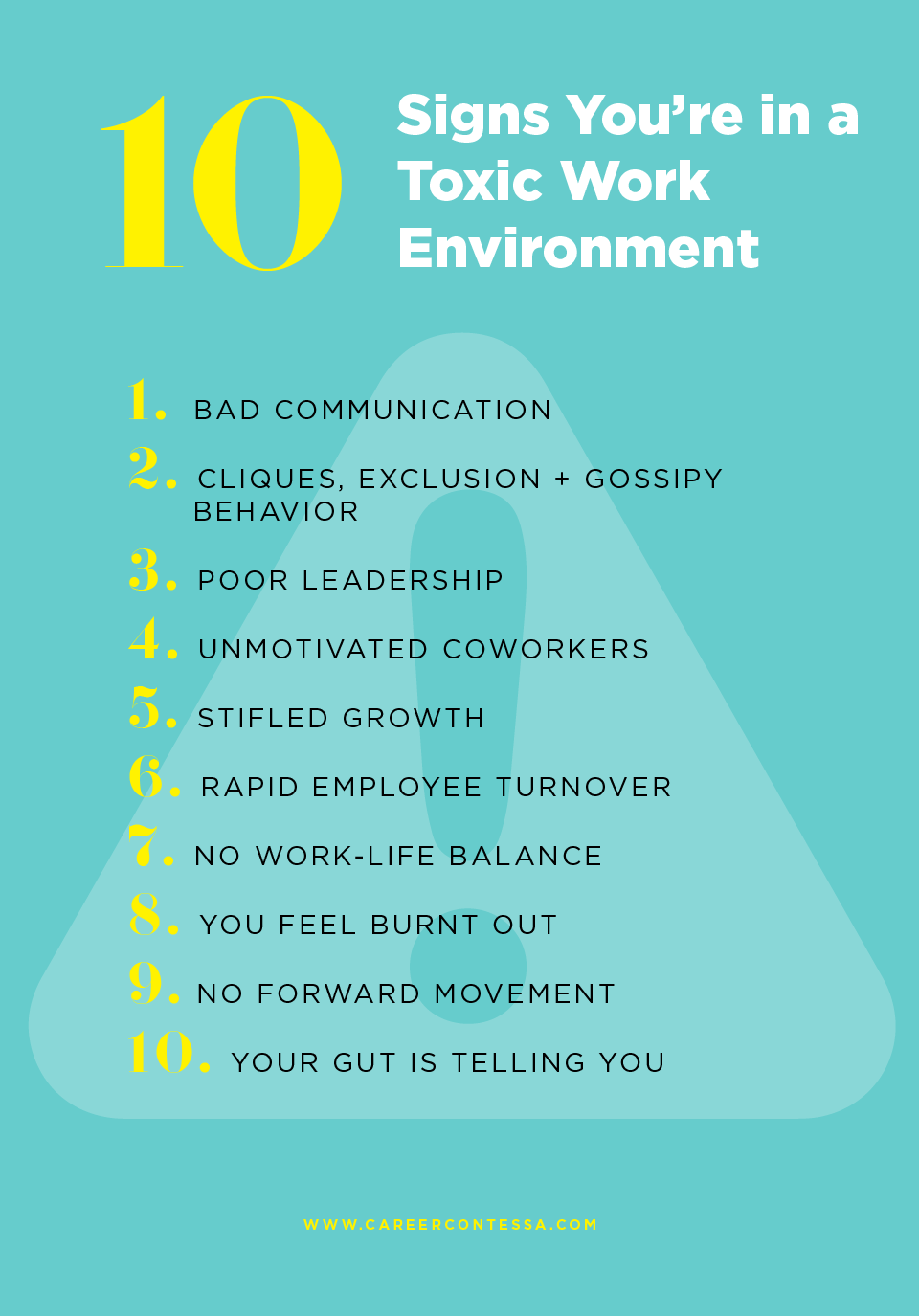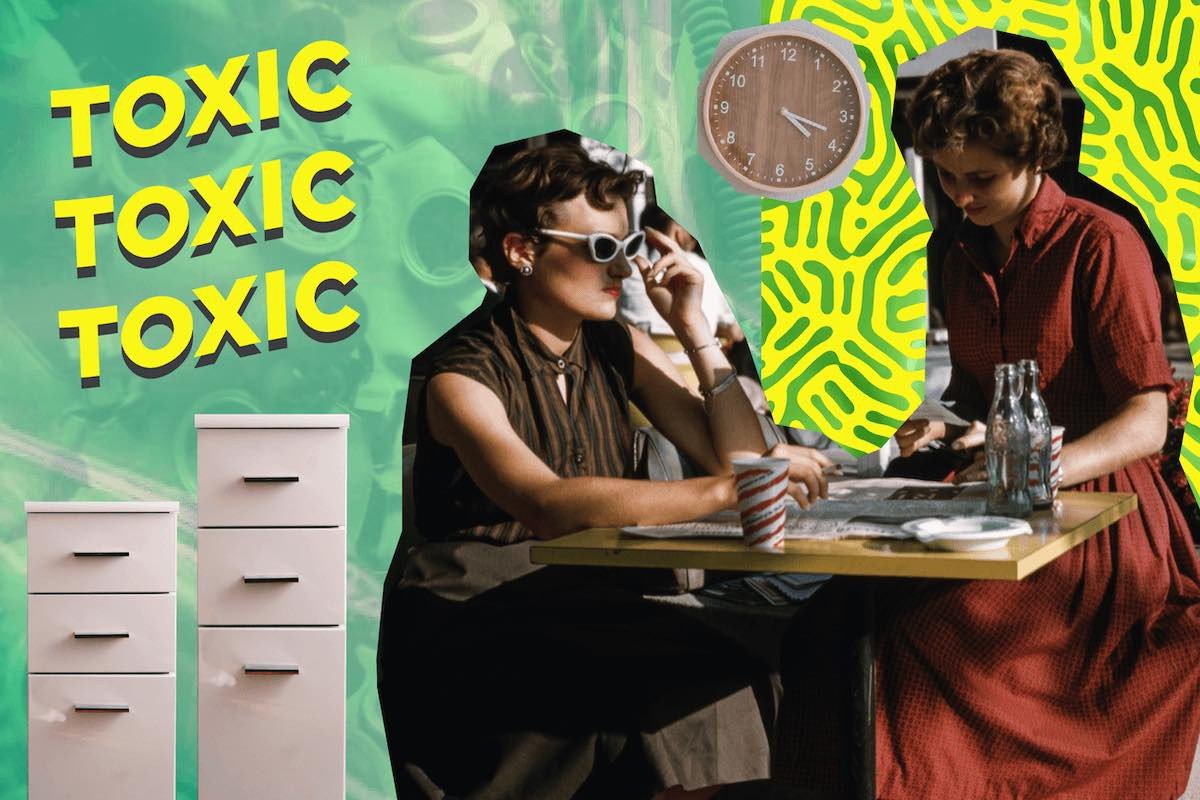Photo collage by Aliya Kamalova
A toxic work environment is more than a job you “
hate.”
We all have bad Mondays, challenging weeks, and even disappointing months. That’s the cyclical nature of a career.
However, you’re typically able to make it through a bad Monday, survive a challenging week, and learn valuable lessons from a disappointing quarter. A toxic work environment is a workplace that disappoints much more than it enriches.
Table of Contents
What is a Toxic Work Environment?
A toxic workplace does not provide psychological safety or any feeling of security. Toxic workplaces often leave employees feeling scared to speak up or to share input. This can lead to stunted professional growth and burnout.
The Signs of a Toxic Work Environment
The following are your best (or worst) indicators of a toxic culture. If your workplace has one of these, it might be toxic but also fixable. If your workplace has several or even all of these markers, skip the hazmat suit and
start looking for a new job.
Toxic work environments breed unrest, competition, low morale, constant stressors, negativity, sickness, high turnover, and even bullying. Even worse? Toxic workplaces rarely stay at work.
They typically follow you home. They take over your conversations with loved ones,
steal away much-needed sleep, and generally cause worry and stress.
So, if you landed on this article because you’re wondering if your work problems are the result of generalized work stress or something worse, let’s dive into ten signs your workplace might actually be suffering from major
dysfunction.
1. A Toxic Workplace May Have Poor Communication
Insufficient, confusing, or scattered communication is the culprit of so many problems in the workplace.
In fact,
communication skills are the most important skills needed in any successful organization. Why?
So much falls under the communication umbrella—including
listening skills (both as a manager and an employee), verbal communication, written communication, preferences on how to communicate—the list goes on!
So, how do you tell if bad communication is leading to workplace toxicity? Here are a few examples of bad communication.
Communication is the root cause of bad organizations—or good organizations operating poorly. Bad communication often leads to confusion and a lack of purpose for employees. From here, problems arise and compound, often leading to all the other items on our list.
What to Do in This Toxic Workplace:
If your company has bad communication methods, hold on tight. You’re likely in a toxic environment that’s only going to get worse with time.
2. A Toxic Work Environment May Have Cliques, Exclusion + Gossipy Behavior
“I want the workplace to feel like eighth grade all over again,” said nobody, ever. So when it does feel like you're back in a middle school cafeteria, it can be pretty deflating.
We all know what a clique looks like. It’s the group of people—whether at work or at school—that sticks together, grabs each other coffee, laughs at inside jokes (of which they somehow have roughly one million), and generally excludes anyone outside of their tight-knit ring.
≠And, while we are all adults here, it can feel extremely alienating to exist on the outside of an active clique.
Simply put, cliques are counterproductive in the workplace. While having workplace friends and acquaintances is good, any behavior that can be described as “clique-ish” is best to be avoided. Steer clear of any cliques,
workplace bullies, or exclusionary groups. Nobody wants to go back to middle school, no matter how good the benefits might be.
Here are a few warning signs you’ve got some Heathers (or Harveys?) in your office:
- Constant feeling of exclusion from a group of people
- A particular group of toxic employees that lunches, grabs coffee, and organizes happy hours together
- Projects often are offered to a particular group, regardless of talent or experience
- Large parts of the workday are spent whispering or chatting on messaging platforms
- General outward disinterest from the group in anyone else—unless it involves gossip or “drama”
What to Do in This Toxic Workplace:
If you recognize that clique-ish behavior includes management and executive-level employees, then you may very well have an organizational mean problem—and that’s about as toxic as it gets.
3. A Toxic Workplace May Have Bad Leadership
Here’s a big one.
There’s the old saying, “You don’t leave a job, you leave a bad boss,” for a reason. Bad leadership can seep into every fiber of an organization—and it often does. We profiled
eleven types of bad bosses and how to handle them, but here’s the thing…
Sometimes a bad boss is the product of their bad boss—and so on. It’s this generational hierarchy of poor leadership that make the overall workplace—you guessed it—downright toxic.
Bad bosses wear a variety of hats. You might have
a micromanaging boss who constantly corrects you, undermines your decisions, and ultimately disallows you from doing your job.
You might have
the “Blame Game” boss, who is quick to pass mistakes on to anyone but themselves. Or, you might be lucky enough to have
the “No Respect” boss, who emails at all hours, forgets how to spell your name, and likely doesn’t even know what you do.
What to Do in This Toxic Workplace:
Bad leadership is a sign of a toxic workplace if you have no recourse.
Leadership conduct is extremely important. It sets the tone for how others behave at work. If there is an HR department—or if your
bad boss has a pretty decent boss—you can try communicating these issues.
4. A Toxic Work Environment Likely Has Unmotivated Coworkers
We’re not saying that you should judge your work on the quality (or lack of quality) of those around you.
However, when you find yourself in a workplace full of
unmotivated coworkers, it’s going to take its toll on you. You might have two reactions to unmotivated coworkers.
- You’re going to shoulder a ton of work that they aren’t handling—and find yourself burnt out
- Their lack of motivation is going to bum you out—and burn you out with a type of underchallenged burnout
Just like your colleagues can
motivate you to work harder, be better, and incubate new ideas, they can wear you down. Unmotivated employees are usually a result of a much larger organizational problem.
Perhaps it’s bad communication from the top. It might be disorganization, disenfranchisement with leadership, or general distrust. Whatever it is, if everyone around you is unmotivated, you’re in a toxic work environment.
What to Do in This Toxic Workplace:
Unfortunately, unless you’re in a leadership position, this problem is indicative of much larger problems—and it’s unlikely that you are going to learn or grow in this environment.
5. A Toxic Workplace May Have Stifled Growth
Speaking of growth, if you’re not experiencing it, your workplace might be toxic—even if it’s just personally toxic for you.
If your workplace doesn't seem to offer any mobility,
learning opportunities for advancing your skills or career, or mentorship, they are likely not invested in the growth of their employees. Once you’ve recognized that you have nowhere to grow, it might be time to change the soil.
What to Do in This Toxic Workplace:
6. A Toxic Work Environment Likely Has Rapid Employee Turnover
Rapid employee turnover is a pretttttttty sure sign that a workplace is toxic.
Leaving a job is a tough decision to make. When you notice that several people are making that decision, then something is really rotten.
Conversely, if employees are constantly
being laid off or fired, this can be a sign of a few other toxic elements.
A high turnover rate usually means there’s disorganization, lack of direction, bad leadership, or little opportunity. Pay attention to the turnover rate in your company.
What to Do in This Toxic Workplace:
Rapid turnover is a big sign that things are bad—or about to get worse. If you can, try speaking with some of the employees who either left, were fired, or were laid off.
7. A Toxic Workplace Often Has No Work-Life Balance
You deserve to have a full life outside of work.
You should be able to toggle your Slack notifications to OFF. You should be able to leave an email unread after dinner on a Tuesday. You should be able to make your dentist appointment without feeling guilty.
YOU SHOULD TAKE THE VACATION DAYS THAT YOU EARNED.
Work-life balance is essential to survival. No human should be expected to be on the clock at all times. If your job requires that you be on-call at all times, it’s toxic. If your boss requires you to answer emails mid-Saturday—every Saturday—your job is toxic.
Yes, at times, things come up at inopportune hours. However, if you are working under the expectation that you are always to be available for work, your job (in our humble opinion) is toxic garbage.
What to Do in This Toxic Workplace:
A good way to avoid these types of toxic workplaces is by
setting healthy work boundaries. If your boundaries can’t be met, or at least compromised, it’s probably not for you.
Real-Life Example of Building Boundaries at a Toxic Workplace
How I Set Workplace Boundaries from Career Contessa Coach, Marnie LemonikWhat: I proactively communicate expectations on response times with co-workers.
How: I use pre-existing functions in Slack to let my team and boss know when they can expect to hear from me. I make sure my “work hours” in Slack are up-to-date, including my timezone, and I set my status anytime I’m away with a detailed message. Instead of an “OOO” status, I’ll simply list out “OOO, Back Monday (10/16)”.
Outcome: These small shifts help to clarify when my co-workers can expect to hear from me, which leaves no room for guessing. I feel empowered knowing I can over-communicate in my daily routine, regardless of what is happening at a company-level.
8. A Toxic Workplace Leaves You Battling Burnout
We’ve touched upon burnout a little bit in this article. Burnout is more than a buzzword you may have heard around workplace jargon.
Workplace burnout is recognized by the World Health Organization as a legitimate medical diagnosis.
Burnout can be a surefire sign of toxic work environments—or at least a work environment that doesn’t “work” for you. Here are three types of burnout. Do any of these sound familiar to you?
- Frenetic Burnout: Frenetic burnout is experienced by employees who put a ton of energy into their work in the hopes that the output will be rewarding. After a sustained period of dedicated work, the frenetic worker does not find positive outcomes.
- Underchallenged Burnout: This type of burnout occurs when an employee feels underchallenged and bored at work. Being unable to find any satisfaction in a job, the underchallenged employees find themselves in a lowered mood.
- Worn-out Burnout: The worn-out employee is someone who is resigned about their work after experiencing consistent work stress over a long period of time. Having experienced negligible rewards, the worn-out employee feels disillusioned and uninspired by the job at hand.
What to Do in This Toxic Workplace:
If you’re suffering from any of these types of workplace burnout, seriously consider fleeing your toxic workplace.
9. A Toxic Workplace Has Little or No Forward Movement
Sometimes, toxic work cultures grow from some sort of seedling.
Whether the seed is a bad manager, a damaging fiscal year, or an organization-wide failure to uphold the company’s mission, this is where things start to go south.
If you find that you once described your job as “so great!” and that now you can’t muster a good word, you’re probably experiencing a brand new toxicity—one where you will no longer move forward.
If your movement stalls or halts to a complete stop, it’s usually the symptom of a larger problem.
The takeaway? If there’s no forward movement in your career, especially in one where you previously experienced growth, it’s a sign that things are toxifying. It might be time to
consider quitting your job.
10. A Toxic Workplace Triggers a Gut Feeling
Just like when you eat spoiled food or too much candy, your gut is your best warning sign.
If your
intuition is telling you that your workplace is bad, it’s probably bad. If your anxiety is through the roof, if you suspect you're experiencing discrimination, if your physical health is suffering—and all of this is happening on a regular basis, there's a big problem.
Listen to it.
If all of the above seems reflective of your workplace, your workplace might be worse than toxic. You might be in
a hostile work environment. Hostile work environments are even worse—and it's likely that a lot of the inter-office behavior is actually illegal.
Look for some of these characteristics of an absolutely hostile work environment:
- Sexual harassment
- Lack of inclusion
- Comments about sexual orientation, race, creed, or disability
- No human resources (in a company larger than 15 or 20 people this is a problem)
- Bullying
- Groups of people at odds with others
Signs of a Toxic Environment—When Working From Home
Think toxicity "doesn't happen" when you're working from home? Think again!
Just because you're not face-to-face with your coworkers, a
particularly toxic boss, or an overwhelming work culture does not mean that toxicity vanishes into thin air.
If your brick-and-mortar office was toxic, then it's likely that the same toxic behaviors will find a way to root their way into your work-from-home situation. It's best to be as aware as possible.
Here are a few signs that your office toxicity has snuck right into your home office.
Office Gossip Moves Online
The good news?
Office gossip that happens online—whether through messaging apps, side emails, or post-meeting summaries, is pretty trackable. The bad news? It's still as damaging, wasteful, and toxic as gossip IRL.
While leaving a digital trail of disparaging comments or even
bullying behavior is foolish (that's a polite word for it), some
toxic coworkers will still do it. If you see it happening in your digital workplace, you have a few options.
First of all, don't engage in anything that might even resemble gossip. Sure, you're working at home, you're bored, and office gossip can be entertaining, but it's a useless waste of time.
Additionally, it can be difficult to ascertain whether or not what you're experiencing is actually gossip.
According to research from body language expert Albert Mehrabian, 38 percent of a message’s impact comes from vocal cues, including tone, and the remaining 55 percent is nonverbal altogether.
If you can't decipher what a message means, ask questions. If what you're seeing is, indeed, just gossip, don't engage. If it's particularly damaging or targeted toward a certain person (even yourself!) collect evidence.
One advantage of working online is that it can, in instances, be easier to shut down toxic conversations without having a difficult conversation face-to-face.
Digital Meetings Overlook Employees
If you're someone who finds it difficult to speak up during in-person meetings, then
taking your weekly meetings online could make everything that much worse. I mean, there's literally a function to mute meeting attendees.
Beyond that, you have your run-of-the-mill technical difficulties like lag time, interruption, the "can anyone actually hear me?" conundrum, and the overall lack of eye-to-eye contact that you might take for granted in an in-person meeting.
If you feel that your
remote meetings are only allowing for one person to speak, speak to your manager about it. Consider a way to create time for all team members to contribute by creating meeting agendas—and sticking to them.
Your Burnout (+ Everyone's Burnout) Is Even Worse
You're finally rid of that commute that sucks up 45 minutes of your day, in each direction. So, why is your burnout feeling worse than ever before?
Couple your job with home stressors, childcare, your partner navigating an entirely different career within earshot, and the dissolution of your home into
a 24/7 office, you've got the recipe for workplace burnout.
Now, imagine everyone on your team is also
experiencing burnout. Suddenly, your Marketing Associate's late email seems like a personal affront. Don't they
know how busy you are? What an insult!
Workplace burnout can quickly turn a formerly healthy workplace into a toxic one. You can combat this by scheduling 1:1 meetings, downtime, by authentically
encouraging self-care, and by scheduling "delight" into your work weeks.
Communication is the key to making
digital collaboration work. Find ways for your team to replicate water cooler time, to connect, and to separate from work in order to calibrate from time to time.












